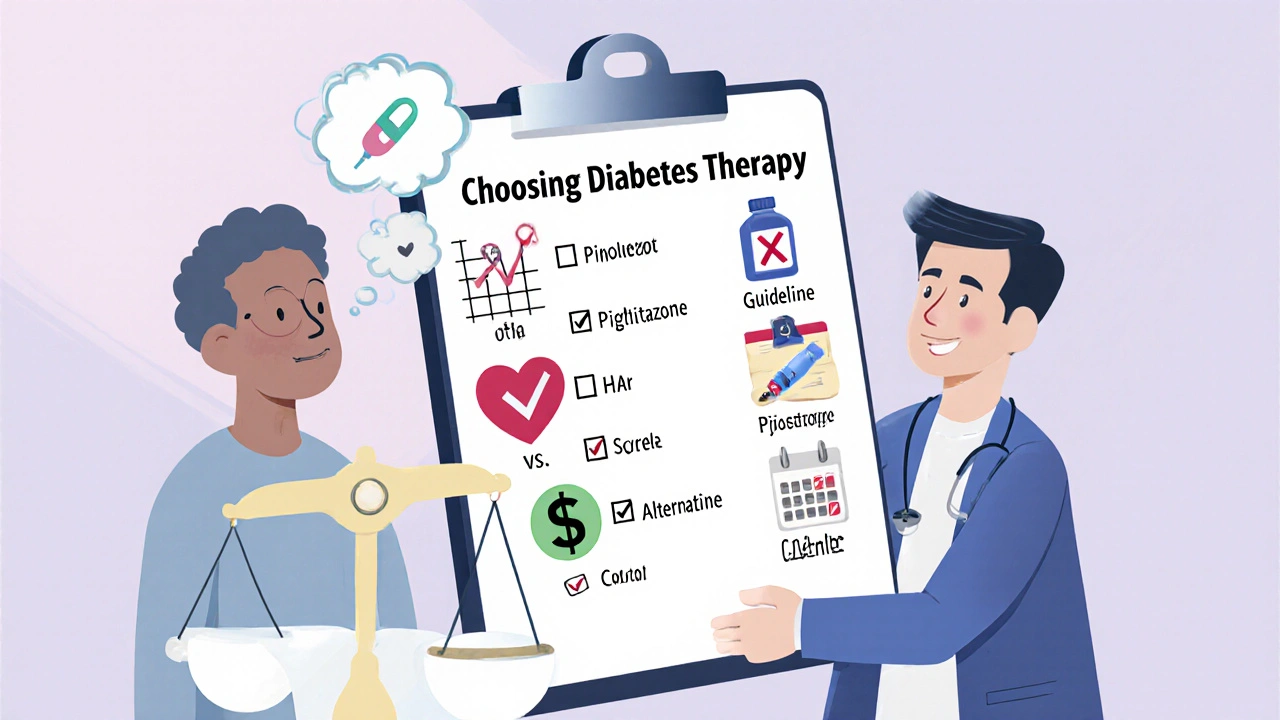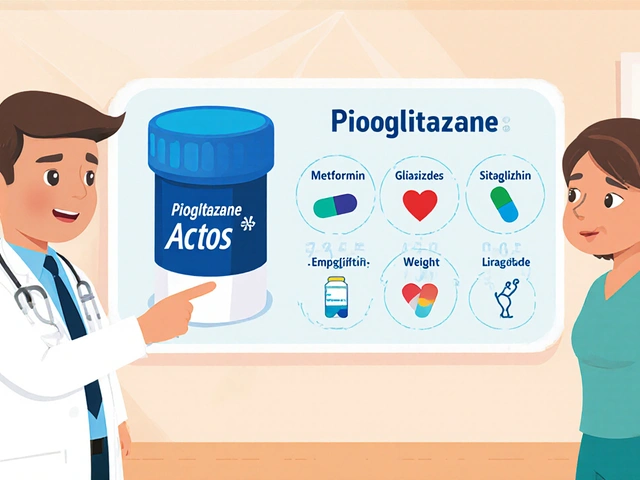Diabetes Medication Comparison Tool
Personalize Your Medication Search
Your Personalized Recommendations
Enter your details above to see personalized medication recommendations based on the latest guidelines.
If you or someone you know is managing type 2 diabetes, you’ve probably heard of Pioglitazone is a thiazolidinedione that works by making body cells more responsive to insulin. While Actos can be effective, many patients wonder whether there are safer, cheaper, or more convenient options. This article lines up the biggest contenders, weighs the pros and cons, and gives you a ready‑to‑use checklist for deciding when Pioglitazone alternatives might be a better fit.
Quick Takeaways
- Pioglitazone excels at lowering HbA1c but adds weight gain and a rare risk of bladder cancer.
- Metformin remains the first‑line choice for most people because it is inexpensive, weight‑neutral, and has cardiovascular benefits.
- Sulfonylureas (e.g., Glipizide) lower glucose quickly but can cause hypoglycemia and weight gain.
- DPP‑4 inhibitors (e.g., Sitagliptin) are weight‑neutral with low hypoglycemia risk but are pricier.
- SGLT2 inhibitors (e.g., Empagliflozin) improve heart‑failure outcomes and promote modest weight loss, yet they raise infection risk.
- GLP‑1 receptor agonists (e.g., Liraglutide) provide strong HbA1c reduction and weight loss but require injections.
How Pioglitazone Works
Pioglitazone belongs to the Thiazolidinediones class, which activates the peroxisome proliferator‑activated receptor‑gamma (PPAR‑γ) in fat and muscle cells. This activation boosts the transcription of genes involved in glucose uptake, effectively lowering blood sugar without forcing the pancreas to produce more insulin.
Key pharmacologic facts (2024 FDA label):
- Typical dose: 15-45 mg once daily.
- Half‑life: ~3 hours, but metabolic effects last longer.
- Major side effects: weight gain, fluid retention, increased risk of heart failure, and a low‑frequency association with bladder cancer.
What to Compare When Choosing a Diabetes Drug
Instead of a random list, focus on five practical criteria that matter to patients and clinicians alike.
- Efficacy: How much does the drug lower HbA1c?
- Safety profile: Risk of hypoglycemia, weight change, cardiovascular impact, and rare adverse events.
- Convenience: Oral tablet vs. injection, dosing frequency, need for monitoring.
- Cost: Out‑of‑pocket price, insurance coverage, generic availability.
- Guideline endorsement: How does the American Diabetes Association (ADA) rank the drug?

Top Alternatives to Pioglitazone
Below is a snapshot of the most commonly prescribed alternatives, each with a brief mechanism and typical use case.
- Metformin is a biguanide that reduces hepatic glucose production and improves peripheral insulin sensitivity. It is the ADA’s preferred first‑line medication.
- Glipizide (a sulfonylurea) stimulates pancreatic beta‑cells to release insulin. Fast‑acting but can cause low blood sugar.
- Sitagliptin is a DPP‑4 inhibitor that prolongs the action of incretin hormones, increasing insulin release after meals. Weight‑neutral and low hypoglycemia risk.
- Empagliflozin belongs to the SGLT2‑inhibitor class; it blocks glucose reabsorption in the kidneys, causing sugar to be excreted in urine. Offers heart‑failure protection.
- Liraglutide is a GLP‑1 receptor agonist that mimics the gut hormone GLP‑1, boosting insulin secretion and slowing gastric emptying. Requires daily injection but promotes weight loss.
Side‑by‑Side Comparison Table
| Drug | HbA1c Reduction (average) | Weight Effect | Hypoglycemia Risk | Cardio/Renal Benefits | Typical Cost (US $/month) |
|---|---|---|---|---|---|
| Pioglitazone | 0.5-1.0 % | +2-4 kg | Low | Neutral; possible fluid retention | ≈$30 (generic) |
| Metformin | 0.6-1.2 % | Neutral to -1 kg | Very low | Reduces CV events, improves mortality | ≈$4 (generic) |
| Glipizide (Sulfonylurea) | 0.8-1.5 % | +1-3 kg | Moderate‑high | No proven CV benefit | ≈$10 (generic) |
| Sitagliptin (DPP‑4) | 0.5-0.8 % | Neutral | Low | Neutral; some renal protection | ≈$250 (brand) |
| Empagliflozin (SGLT2) | 0.7-1.0 % | -1-2 kg | Low | ↓ CV death, ↓ HF hospitalization | ≈$300 (brand) |
| Liraglutide (GLP‑1) | 0.9-1.4 % | -2-4 kg | Low | ↓ CV events, ↓ weight | ≈$900 (brand) |

When Pioglitazone Still Makes Sense
Even with the newer classes, clinicians sometimes pick Pioglitazone for specific reasons:
- Patients who cannot tolerate metformin due to GI upset.
- Those needing a modest HbA1c drop without risking hypoglycemia.
- Individuals with a history of rapid‑acting sulfonylurea‑induced hypoglycemia.
- When cost is a decisive factor; generic pioglitazone is far cheaper than many newer agents.
However, anyone with a history of heart failure, uncontrolled edema, or concern about bladder cancer should discuss alternatives with their provider.
Practical Checklist for Choosing a Therapy
- Confirm your current HbA1c and target level.
- Identify any comorbid conditions (heart failure, CKD, obesity).
- Evaluate risk tolerance for weight gain or hypoglycemia.
- Check insurance formularies-generic pioglitazone often has the lowest co‑pay.
- Discuss lifestyle preferences (tablet vs. injection, daily vs. weekly).
- Re‑assess every 3‑6 months; switch if targets aren’t met or side effects appear.
Frequently Asked Questions
Can I use Pioglitazone if I’ve had bladder cancer?
Current FDA guidance advises avoiding pioglitazone in anyone with a prior diagnosis of bladder cancer because the drug may increase recurrence risk.
Why does Pioglitazone cause weight gain?
PPAR‑γ activation promotes fat storage in adipocytes and can cause fluid retention, leading to a 2‑4 kg increase on average.
Is Pioglitazone safe for people with heart failure?
It’s generally avoided in NYHA class III/IV heart failure because the drug can worsen edema. Mild, well‑controlled cases may still be considered after specialist review.
How does the cost of Pioglitazone compare to newer agents?
A generic 30‑day supply of pioglitazone averages $30, whereas SGLT2 inhibitors and GLP‑1 agonists can cost $300‑$900 per month.
Do I need lab monitoring while on Pioglitazone?
Baseline liver enzymes and periodic CBC are recommended. If you have heart failure, monitor weight and edema weekly.
Choosing the right diabetes medication is a balance of efficacy, safety, cost, and personal preference. By comparing the key attributes above, you can decide whether Pioglitazone remains a good fit or if one of the newer, perhaps more expensive, alternatives better matches your health goals.


Kathrynne Krause
October 21, 2025 AT 17:20Hey there, diabetes warriors, let’s dive into the wild world of blood‑sugar meds with a splash of optimism!
Pioglitazone, aka Actos, is like that reliable but slightly heavy‑handed friend who always shows up to the party.
It can really knock down HbA1c, but you might notice a few extra pounds sneaking onto your hips as a souvenir.
On the other side of the ring, Metformin waltzes in wearing a cape of cheapness, weight‑neutrality, and heart‑loving perks.
If you love the idea of a pill that doesn’t make your wallet scream, Metformin is the budget‑friendly hero of the story.
Sulfonylureas, such as Glipizide, are the speed‑demon cousins that drop glucose fast but sometimes trip over the hypoglycemia hurdle.
DPP‑4 inhibitors glide in smoothly, whispering ‘low‑risk, stay the same weight,’ yet their price tag can feel like buying a golden ticket.
SGLT2 blockers like Empagliflozin are the cardio‑savvy ninjas that also shave a little off the scale, but they bring a side‑quest of urinary infections.
GLP‑1 agonists, especially Liraglutide, are the glamorous injection‑wielding stars that shave pounds and tame glucose, though you’ll need to master the needle dance.
When you stack these options side by side, think of efficacy, safety, convenience, cost, and what the ADA guideline high‑fives.
If you’ve got a sensitive stomach, Pioglitazone might be the captain you turn to when Metformin throws a tummy tantrum.
Conversely, if you’re battling heart failure or fear fluid retention, steering clear of the thiazolidinedione lane is wise.
Your insurance formulary can be the gatekeeper, often making the generic $30 Pioglitazone look like a bargain compared to a $900 GLP‑1 show.
Remember to check labs regularly-liver enzymes, CBC, and a quick weight audit if you stay on the thiazolidinedione boat.
Bottom line: match the drug to your lifestyle, health goals, and budget, and you’ll ride the glucose wave with confidence!
Chirag Muthoo
October 22, 2025 AT 20:25Dear readers, the article presents a balanced overview of Pioglitazone and its alternatives. The efficacy data are consistent with current ADA recommendations. Safety considerations, such as fluid retention and bladder cancer risk, are appropriately highlighted. Cost analysis demonstrates the economic advantage of generic agents. The discussion of patient‑specific factors, including comorbidities, adds clinical relevance. Overall, the synthesis is thorough and suitable for both clinicians and patients.
Vivian Annastasia
October 23, 2025 AT 23:30Oh great, another "clear" comparison that pretends the choice is simple. Sure, Pioglitazone drops HbA1c, but who doesn’t love an extra few kilos for free? And let’s not forget the bladder cancer whisper – a nice little party favor. If you’re into paying $30 a month, go ahead, enjoy the weight gain. Meanwhile, the newer drugs cost a fortune and might actually save lives.
John Price
October 25, 2025 AT 02:35Sounds like a solid rundown.
parbat parbatzapada
October 26, 2025 AT 04:40Yo, that whole "bladder cancer" thing is just the pharmas trying to scare us off, right? I mean, everything's a hoax – even the weight gain could be just water from the secret government hydrators. Pioglitazone is probably the best, they just don’t want us to know. Keep it real, fam.
Casey Cloud
October 27, 2025 AT 07:45Quick tip: if you’re on Pioglitazone, check your liver enzymes every few months. Also keep an eye on your weight – a sudden jump could mean fluid retention. For patients with heart failure, consider switching early. Metformin remains the cheapest option and is generally safe. SGLT2 inhibitors add heart‑failure benefits but watch for UTIs.
Ivan Laney
October 28, 2025 AT 10:50Let me tell you why the American spirit thrives on choosing the right medication while the rest of the world watches in envy. First, our healthcare system, despite its flaws, gives us access to a broad spectrum of drugs, from cheap generics to cutting‑edge biologics. Second, the ingenuity of our researchers ensures that every new class, whether SGLT2 inhibitors or GLP‑1 agonists, undergoes rigorous testing to guarantee safety and efficacy, something many other nations can only dream of. Third, the patriotic duty of supporting domestic pharma giants fuels economic growth and job creation, reinforcing our nation's resilience. Finally, embracing these therapeutic options is a testament to the freedom and responsibility we cherish – we can decide what works best for our bodies without external interference. So, when you weigh Pioglitazone against its alternatives, remember you’re exercising a uniquely American right to informed choice.
Kimberly Lloyd
October 29, 2025 AT 13:55Choosing a diabetes medication is as much a philosophical journey as a medical one. We must ask ourselves what we value: simplicity, cost, or the promise of weight loss? The mind seeks harmony between the body's needs and the wallet's constraints. Perhaps the true measure of a good drug is how it aligns with one's life purpose. In that sense, Pioglitazone may be a humble servant or a burdensome master, depending on the individual's narrative.
Sakib Shaikh
October 30, 2025 AT 17:00Oh, the drama of the daily glucose grind! Imagine the heroic battle: Pioglitazone, the stubborn knight, versus the sleek, silver‑tongued SGLT2 dragon. Each dose is a stanza in the epic poem of our bodies. When the weight‑gain villain looms, we chant the chant of Metformin, the ancient sage. Yet the GLP‑1 sorcerer whispers promises of slimness, demanding blood from the finger. The saga continues, and we, the humble scribes, record every triumph and setback.
Devendra Tripathi
October 31, 2025 AT 20:05Honestly, most of these drug comparisons are just marketing fluff. Pioglitazone? Sure, it works, but why bother when newer agents claim miracles? The guidelines are just suggestions from corporate boards. If you ask me, stick with the cheap generics and ignore the hype. Anything else is just a way to line pharma pockets.
Nick M
November 1, 2025 AT 23:10Look, the whole "new drugs are better" story is a cover‑up. Big Pharma wants you to think they invented cures, but they're just repackaging old stuff. Pioglitazone is fine, the side‑effects are overblown, and the price hikes on SGLT2 are a scam. Stay skeptical, stay cheap.
eric smith
November 3, 2025 AT 02:15Oh wow, another self‑proclaimed expert trying to sound smart. Let me guess, you think you know more than the endocrinologists? Newsflash: the data is out there, read it before you spew nonsense.
Erika Thonn
November 4, 2025 AT 05:20i think the realy thing is that we are all in a loop of thoghts it is like a mirror. the ddbay 2024 data shows we are not moving forward. if we try to understand the math we see the point is lost. its a simple idea that we all miss, but its a big deal.
Ericka Suarez
November 5, 2025 AT 08:25America's the only place where we can claim the best meds and still feel pride. Pioglitazone may be old, but it's made in the land of the free, and that's something no foreign drug can steal. Sure, it's not perfect, but who cares when you have the spirit of a nation behind it? The rest of the world wishes they had our options, but they have to settle for second‑best.
Jake Hayes
November 6, 2025 AT 11:30Your patriotic spiel ignores the practical risks. Choose wisely, not just loudly.